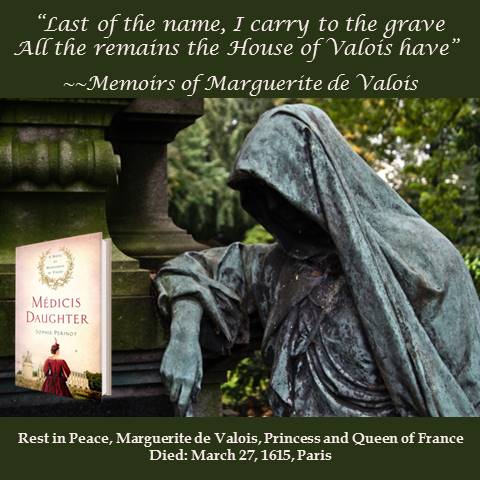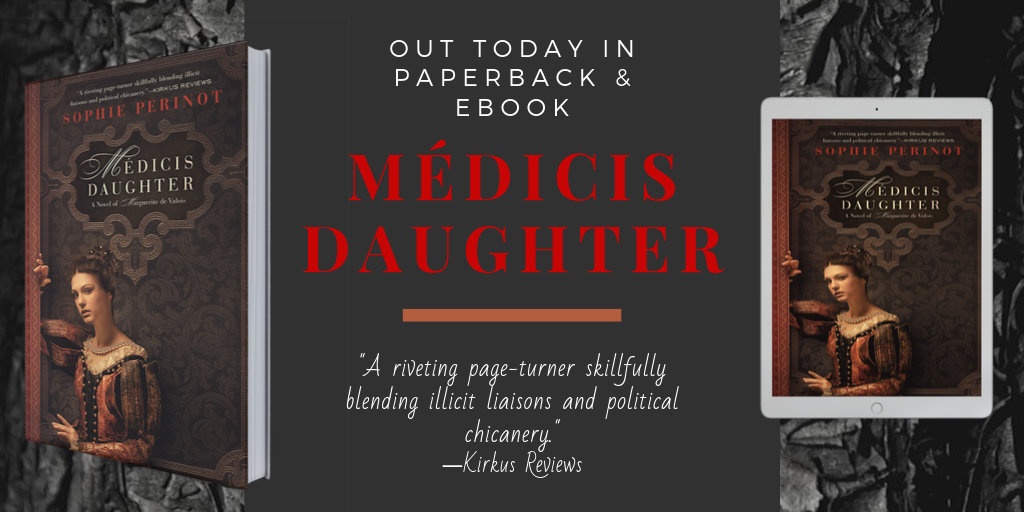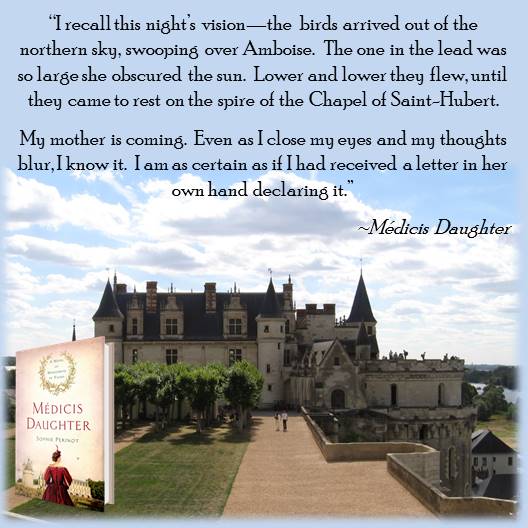Tag: Marguerite de Valois
However picky she is . . . at least your mother is NOT Queen Catherine de Médicis
Had a bit of fun imagining what it would be like to be shopping for Queen Catherine de Médicis this Mother’s Day.
Poor Princess Margot—Catherine’s youngest daughter and the main character in my novel Médicis Daughter: A Novel of Marguerite de Valois! I mean the mother-daughter relationship is always somewhat perilous. But when your mom is Catherine de Médicis the peril isn’t just emotional, it can rather quickly turn deadly.
ENJOY! And maybe consider giving your mother a book this Mother’s Day 😉
Médicis Daughter Out in PAPERBACK TODAY!!!
At last, at last!!! So many readers have been asking me: when will Médicis Daughter release in paperback? When will it be available in ebook format again? Well, the wait is over!
MÉDICIS DAUGHTER my dark tale of Marguerite de Valois, daughter of Catherine de Médicis, sister to three kings, is NOW AVAILABLE IN PAPERBACK AND EBOOK!
So what do you think of THE NEW COVER? Let me know in the comments below!
⚜ ⚜ PRAISE FOR MÉDICIS DAUGHTER ⚜ ⚜
Amid the glamorous intrigues of the 16th-century French court, Marguerite de Valois,. . . deftly balances secret escapades and public duties… Perinot matches the rhythm of Margot’s life to the political storms: as the battles escalate, so do the perils of love and lust. A riveting page-turner skillfully blending illicit liaisons and political chicanery.”―Kirkus Reviews
This is Renaissance France meets Game of Thrones: dark, sumptuous historical fiction that coils religious strife, court intrigue, passionate love, family hatred, and betrayed innocence like a nest of poisonous snakes.” ―Kate Quinn, New York Times bestselling author of The Huntress
Absorbing… an engrossing read.”―Publishers Weekly
An enthralling page-turner which lovers of royalty fiction and strong female leads should enjoy thoroughly.”―HNR Magazine
⚜ ⚜ ⚜ BUY LINKS ⚜ ⚜ ⚜
AMAZON:
Paperback
B&N:
NOOK
Paperback
Something Wicked This Way Comes . . .
Because it is the time of year when “something wicked this way comes” and nobody does wicked like the royal Valois . . . Voila! my Halloween season book-trailer for Médicis Daughter. Enjoy!
Intrigued? Pick up a copy of Médicis Daughter
on Amazon, or wherever books are sold.
Marguerite de Valois and Mary Queen of Scots
After the finale of CW’s Reign—which featured a cameo by the youngest Valois Princess, Marguerite—a number of the shows fans have reached out to me about who Margot was. Of course I’ve written a whole novel on that 😉 but I thought I might do a few posts showing how Margot’s life overlapped with that of Mary Queen of Scots while that lady was in France.
Margot and Mary #1: As a little girl Princess Margot passed significant time with Mary Queen of Scots. In fact, the French Princess and youngest daughter of Catherine de Médicis passed her earliest years at Saint-Germain in the company of her elder sisters Elisabeth (destined to be Queen of Spain) and Claude (future Duchess of Lorraine), and her future sister-in-law Mary Stuart.
After Margot’s sisters married (the last married in 1559 when Margot was 6) she spent most of her time at the Château de Vincennes with her younger brothers Henri (Duc d’Anjou) and François (at that time—before the death of Francis II and before his confirmation—called Hercule. Then the Massacre of Vassy occurred (March 1562) and Catherine de Médicis kept only her son Henri with her while sending her two youngest—Margot and François—to Amboise. The Château of Amboise was chosen because it was peaceful and sufficiently removed from the theater of war to prove a safe retreat. It is at this Château, with Margot anticipating a visit from her powerful mother, that my novel MÉDICIS DAUGHTER begins.
Mothers’ Day Shopping for Queen Catherine de Médicis
Think your Mom is hard to select a Mothers’ Day gift for? Here is my humorous take on poor Marguerite de Valois—youngest daughter of Catherine de Médicis and central character in my most recent novel, Médicis Daughter—trying to pick out the perfect gift for her mother.
Oh and Mothers’ Day is just a week away readers, so mail those cards and pick up those last minute presents. And remember, books make GREAT gifts.
Rest In Peace, Marguerite de Valois
This is the four-hundred-and-second anniversary of the death of Marguerite de Valois, Princess and then Queen of France, and central character in my novel, MÉDICIS DAUGHTER. Marguerite was the 8th child of Henri II of France and his queen Catherine de Médicis. Healthy, intelligent and beautiful—Margot was, sadly, never anyone’s favorite child, and may well have been Catherine’s least favorite. As I say in the authors to my novel:
Fate was not so kind to Marguerite de Valois. Nor was history.
 Salic law kept her from ruling in France after the death of her last brother, with the crown passing to her cousin/husband the King of Navarre. And a single anonymous political pamphlet during her lifetime was later taken for history not slander, leaving people with the impression Margot was nothing more than a wanton sex-addict. Yet the historical record shows that Marguerite was highly intelligent, politically astute, and (in her later years) a serious force in the literary life of France. She also had a fierce conscience.
Salic law kept her from ruling in France after the death of her last brother, with the crown passing to her cousin/husband the King of Navarre. And a single anonymous political pamphlet during her lifetime was later taken for history not slander, leaving people with the impression Margot was nothing more than a wanton sex-addict. Yet the historical record shows that Marguerite was highly intelligent, politically astute, and (in her later years) a serious force in the literary life of France. She also had a fierce conscience.
I hope that in my novel I did this Princess justice. For those who enjoyed my book, I recommend reading Margot’s own Memoirs—which provide a vivid exposition of France during her lifetime.
MÉDICIS DAUGHTER on Amazon http://amzn.to/2nBP3bU
At Book Depository [FREE worldwide shipping] http://bit.ly/2o4yNwJ
At Barnes & Noble http://bit.ly/1qk7Ztw
Spring! A Young Woman Thinks of Love
Ah, what a wonderful thing it is to be young and in love–unless you are a 16th century Valois Princess and your mother, Catherine de Médicis, disapproves of your entanglement. That is precisely the situation of my heroine, Princess Marguerite, in Médicis Daughter. Of course she should have known that marriage is not a matter of love when you are a royal. After all didn’t her dear friend and mentor, Henriette Duchess de Nevers, warn her long ago:
Fair of face’ is a fine consideration for flirting but of little import in marrying . . . .“Remember girls, marriage is a matter of politics, finance and family. Looks are for lovers.
What to do, what to do?
Enjoy the Official Spring Trailer for Médicis Daughter!
Another Prospective Groom . . .
The first mention of a match between Marguerite de Valois and Dom Sebastian, King of Portugal, dates back to the reign of Francis II, when the French Ambassador at Lisbon sent Dom Sebastian a portrait of the young Margot. Nothing came of those efforts though and other grooms—as readers of Médicis Daughter know—were subsequently proposed for the youngest Valois Princess.
In July of 1569, however, SERIOUS negotiations re-opened for a marriage between Margot and the young (17) king of Portugal. Fourquevaux (the French Ambassador in Spain) received necessary powers conclude a treaty with Philip II (the King of Portugal’s Uncle) who exercised a protectorate of sorts over his nephew’s kingdom. 
Unfortunately for Margot, like some of her previous prospective grooms, the Portuguese King, while undeniably handsome and powerful, appears to have been seriously flawed. In the first instance he had been reared by a pair of monks who appear to have made him into a serious misogynist. Additionally, Catherine’s ambassadors quickly informed her her that doctors seemed to believe the young man would not live long and that there is some question as to “whether he was ‘of any use to have children.”
None of this dissuaded Catherine de Médicis from pursuing the match however because . . . well . . . there was that power thing.
At first Spanish king also seemed disposed towards the marriage and Pope Pius V was very happy with the idea (as he desired to see a stronger union between the Catholic powers so they could battle the Turks AND the Protestant powers together). The Dowager Queen of Portugal, however, had a preference for marrying her son to an Austrian Archduchess.
Ultimately Dom Sebastian didn’t live long enough to marry anyone and Margot ended up with a groom even less to her liking.
Farewell to a Princess . . .
On this day four-hundred-and-one years ago, Marguerite de Valois, heroine of Médicis Daughter, died.  The last of the Valois was initially buried at the Basilica of St Denis, traditional resting place of French Royals and the place where both her parents and her brothers lay. Unfortunately, the French Revolution showed no respect for the dead. So the bodies of the Bourbon and Valois monarchs were removed from the Basilica to “celebrate” the October 1793 execution of Marie Antoinette, and given ignominious trench burials. The monument that marked Marguerite’s grave was destroyed. Today the location of Marguerite’s tomb is not on maps of burial places at St. Denis, although her brother Henri III and her parents Catherine de Médicis and Henri II are still listed.
The last of the Valois was initially buried at the Basilica of St Denis, traditional resting place of French Royals and the place where both her parents and her brothers lay. Unfortunately, the French Revolution showed no respect for the dead. So the bodies of the Bourbon and Valois monarchs were removed from the Basilica to “celebrate” the October 1793 execution of Marie Antoinette, and given ignominious trench burials. The monument that marked Marguerite’s grave was destroyed. Today the location of Marguerite’s tomb is not on maps of burial places at St. Denis, although her brother Henri III and her parents Catherine de Médicis and Henri II are still listed.
Click here for more on the tragic revolutionary “Profanation at Saint Denis.”
A 6-Week Birthday and the PRESENT is for YOU ;)
Today is the six-week anniversary of the release of Médicis Daughter, and just look how the book has grown! It now has more than 50 reviews on Amazon, was both a Goodreads and a Barnes & Noble fiction pick last month, and has received scads of excellent and thoughtful reviews by book bloggers. And that’s ALL thanks to you my friends—readers, bloggers, fellow historical novelists. So it seems only fair to me that any present marking this occasion MUST go to one of your number.
Thus, I am offering a giveaway—this handy mug which has a twin right here on my very own desk.  Want Marguerite de Valois (at least as I imagine her) beside you when you enjoy your morning coffee? Then please enter.
Want Marguerite de Valois (at least as I imagine her) beside you when you enjoy your morning coffee? Then please enter.
You get one entry for leaving a comment below telling me why you think the Valois run rings around the Tudors when it comes to intrigue and/or sex appeal. Collect another entry for visiting the Médicis Daughter facebook fan page (make sure to “like” it if you haven’t already). And you can earn a whopping TWO additional chances to win should you chose to share a tweet celebrating the novel’s 6-wk birthday!
Contest ends one week from today (January 19th)!


